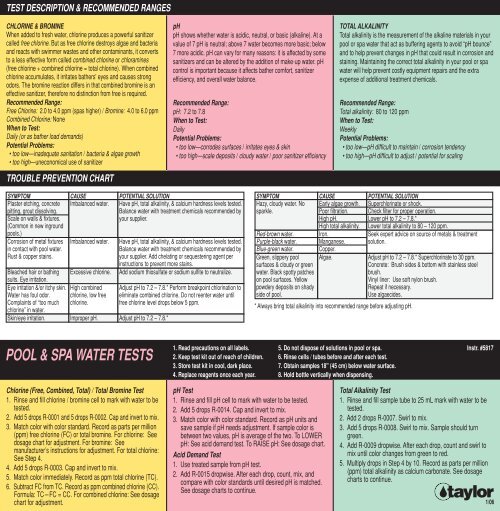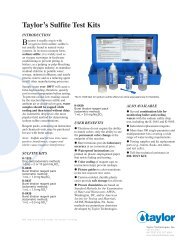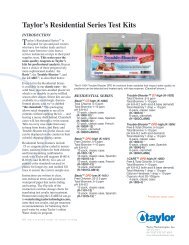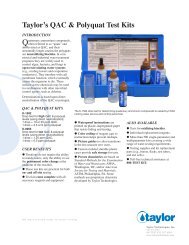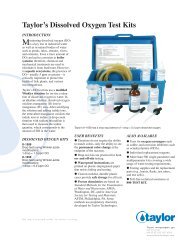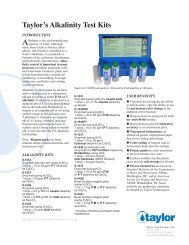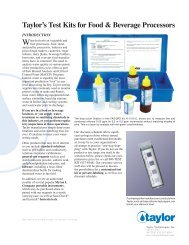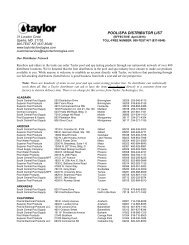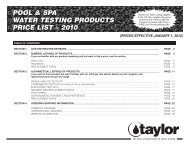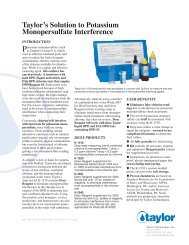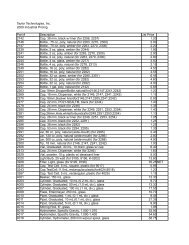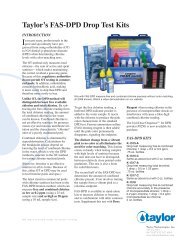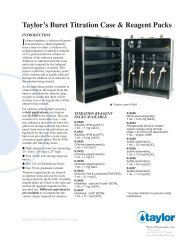5817 - Taylor Technologies
5817 - Taylor Technologies
5817 - Taylor Technologies
You also want an ePaper? Increase the reach of your titles
YUMPU automatically turns print PDFs into web optimized ePapers that Google loves.
TEST DESCRIPTION & RECOMMENDED RANGESCHLORINE & BROMINEWhen added to fresh water, chlorine produces a powerful sanitizercalled free chlorine. But as free chlorine destroys algae and bacteriaand reacts with swimmer wastes and other contaminants, it convertsto a less effective form called combined chlorine or chloramines(free chlorine + combined chlorine = total chlorine). When combinedchlorine accumulates, it irritates bathers' eyes and causes strongodors. The bromine reaction differs in that combined bromine is aneffective sanitizer, therefore no distinction from free is required.Recommended Range:Free Chlorine: 2.0 to 4.0 ppm (spas higher) / Bromine: 4.0 to 6.0 ppmCombined Chlorine: NoneWhen to Test:Daily (or as bather load demands)Potential Problems:• too low—inadequate sanitation / bacteria & algae growth• too high—uneconomical use of sanitizerTROUBLE PREVENTION CHARTpHpH shows whether water is acidic, neutral, or basic (alkaline). At avalue of 7 pH is neutral; above 7 water becomes more basic; below7 more acidic. pH can vary for many reasons: it is affected by somesanitizers and can be altered by the addition of make-up water. pHcontrol is important because it affects bather comfort, sanitizerefficiency, and overall water balance.Recommended Range:pH: 7.2 to 7.8When to Test:DailyPotential Problems:• too low—corrodes surfaces / irritates eyes & skin• too high—scale deposits / cloudy water / poor sanitizer efficiencyTOTAL ALKALINITYTotal alkalinity is the measurement of the alkaline materials in yourpool or spa water that act as buffering agents to avoid “pH bounce”and to help prevent changes in pH that could result in corrosion andstaining. Maintaining the correct total alkalinity in your pool or spawater will help prevent costly equipment repairs and the extraexpense of additional treatment chemicals.Recommended Range:Total alkalinity: 80 to 120 ppmWhen to Test:WeeklyPotential Problems:• too low—pH difficult to maintain / corrosion tendency• too high—pH difficult to adjust / potential for scalingSYMPTOMCAUSEPOTENTIAL SOLUTIONPlaster etching, concrete Imbalanced water. Have pH, total alkalinity, & calcium hardness levels tested.pitting, grout dissolving.Scale on walls & fixtures.(Common in new ingroundpools.)Balance water with treatment chemicals recommended byyour supplier.Corrosion of metal fixturesin contact with pool water.Rust & copper stains.Imbalanced water. Have pH, total alkalinity, & calcium hardness levels tested.Balance water with treatment chemicals recommended byyour supplier. Add chelating or sequestering agent perinstructions to prevent more stains.Bleached hair or bathingsuits. Eye irritation.Excessive chlorine. Add sodium thiosulfate or sodium sulfite to neutralize.Eye irritation &/or itchy skin. High combined Adjust pH to 7.2 – 7.8.* Perform breakpoint chlorination toWater has foul odor.Complaints of “too muchchlorine” in water.chlorine, low freechlorine.eliminate combined chlorine. Do not reenter water untilfree chlorine level drops below 5 ppm.Skin/eye irritation. Improper pH. Adjust pH to 7.2 – 7.8.*SYMPTOMHazy, cloudy water. Nosparkle.Red-brown water.Purple-black water.Blue-green water.Green, slippery poolsurfaces & cloudy or greenwater. Black spotty patcheson pool surfaces. Yellowpowdery deposits on shadyside of pool.CAUSEEarly algae growth.Poor filtration.High pH.High total alkalinity.Iron.Manganese.Copper.Algae.* Always bring total alkalinity into recommended range before adjusting pH.POTENTIAL SOLUTIONSuperchlorinate or shock.Check filter for proper operation.Lower pH to 7.2 – 7.8.*Lower total alkalinity to 80 – 120 ppm.Seek expert advice on source of metals & treatmentsolution.Adjust pH to 7.2 – 7.8.* Superchlorinate to 30 ppm.Concrete: Brush sides & bottom with stainless steelbrush.Vinyl liner: Use soft nylon brush.Repeat if necessary.Use algaecides.POOL & SPA WATER TESTS1. Read precautions on all labels.2. Keep test kit out of reach of children.3. Store test kit in cool, dark place.4. Replace reagents once each year.5. Do not dispose of solutions in pool or spa.6. Rinse cells / tubes before and after each test.7. Obtain samples 18" (45 cm) below water surface.8. Hold bottle vertically when dispensing.Instr. #<strong>5817</strong>Chlorine (Free, Combined, Total) / Total Bromine Test1. Rinse and fill chlorine / bromine cell to mark with water to betested.2. Add 5 drops R-0001 and 5 drops R-0002. Cap and invert to mix.3. Match color with color standard. Record as parts per million(ppm) free chlorine (FC) or total bromine. For chlorine: Seedosage chart for adjustment. For bromine: Seemanufacturer’s instructions for adjustment. For total chlorine:See Step 4.4. Add 5 drops R-0003. Cap and invert to mix.5. Match color immediately. Record as ppm total chlorine (TC).6. Subtract FC from TC. Record as ppm combined chlorine (CC).Formula: TC-FC = CC. For combined chlorine: See dosagechart for adjustment.pH Test1. Rinse and fill pH cell to mark with water to be tested.2. Add 5 drops R-0014. Cap and invert to mix.3. Match color with color standard. Record as pH units andsave sample if pH needs adjustment. If sample color isbetween two values, pH is average of the two. To LOWERpH: See acid demand test. To RAISE pH: See dosage chart.Acid Demand Test1. Use treated sample from pH test.2. Add R-0015 dropwise. After each drop, count, mix, andcompare with color standards until desired pH is matched.See dosage charts to continue.Total Alkalinity Test1. Rinse and fill sample tube to 25 mL mark with water to betested.2. Add 2 drops R-0007. Swirl to mix.3. Add 5 drops R-0008. Swirl to mix. Sample should turngreen.4. Add R-0009 dropwise. After each drop, count and swirl tomix until color changes from green to red.5. Multiply drops in Step 4 by 10. Record as parts per million(ppm) total alkalinity as calcium carbonate. See dosagecharts to continue.1/06
CHLORINE DOSAGE CHARTVolumeof Water(gallons / liters)250 gal / 1,000 L400 gal / 1,500 L1,000 gal / 4,000 L5,000 gal / 20,000 L10,000 gal / 40,000 L15,000 gal / 60,000 L20,000 gal / 80,000 L10%0.32 fl oz / 10.0 mL0.51 fl oz / 15.0 mL1.28 fl oz / 40.0 mL6.40 fl oz / 200 mL12.8 fl oz / 400 mL1.20 pt / 600 mL1.60 pt / 800 mLpH DOSAGE CHARTS12%0.27 fl oz / 8.35 mL0.43 fl oz / 12.5 mL1.07 fl oz / 33.3 mL5.33 fl oz / 167 mL10.7 fl oz / 333 mL1.00 pt / 500 mL1.33 pt / 667 mLTO RAISE CHLORINE 1 PPMUSING CHLORINE COMPOUND*% Available Chlorine45%60%0.07 oz / 2.22 g 0.06 oz / 1.67 g0.12 oz / 3.33 g 0.09 oz / 2.50 g0.30 oz / 8.89 g 0.22 oz / 6.67 g1.48 oz / 44.4 g 1.11 oz / 33.3 g2.97 oz / 88.9 g 2.23 oz / 66.7 g4.44 oz / 133 g 3.34 oz / 100 g5.94 oz / 178 g 4.45 oz / 133 g65%0.05 oz / 1.54 g0.08 oz / 2.31 g0.21 oz / 6.15 g1.03 oz / 30.8 g2.05 oz / 61.5 g3.08 oz / 92.3 g4.11 oz / 123 g75%0.04 oz / 1.42 g0.07 oz / 2.13 g0.20 oz / 5.63 g0.95 oz / 28.3 g1.77 oz / 56.3 g2.66 oz / 84.5 g3.77 oz / 113 gCHLORINEIf you choose to use chlorine as a disinfectant and sanitizer, learn to use itECONOMICALLY and EFFECTIVELY.Effective use is largely dependent on pH. At a high pH (>7.8), chlorine’s abilityto disinfect is significantly reduced. But at a lower pH (7.2 to 7.8), chlorine’sdisinfecting ability is enhanced. Therefore, at lower pH levels, you get moredisinfection for your money.Remember:• Keep the pH at 7.8 or below.• Keep FREE CHLORINE between 2.0 and 4.0 ppm (spas higher).• Periodically superchlorinate to eliminate COMBINED CHLORINE.(Breakpoint dosage equals 10 times the amount of combined chlorine.)• Chlorine-free shocks may be used as an alternative to superchlorination toeliminate bather wastes and other organic contaminants.*Chlorine products contain different amounts of available chlorine. Adjust treatment amountsaccordingly.Volumeof Water(gallons / liters)250 gal / 1,000 L400 gal / 1,500 L1,000 gal / 4,000 L5,000 gal / 20,000 L10,000 gal / 40,000 L15,000 gal / 60,000 L20,000 gal / 80,000 LTO LOWER pHUSING DRY ACID(SODIUM BISULFATE, 93.2%)*Drops of Acid Demand Reagent1 2 30.31 oz / 0.62 oz / 0.93 oz /9.25 g 18.5 g 27.7 g0.49 oz / 0.99 oz / 1.48 oz /13.9 g 27.7 g 41.6 g1.23 oz / 2.46 oz / 3.70 oz /36.9 g 73.8 g 111 g6.16 oz / 12.3 oz / 1.16 lb /185 g 369 g 554 g12.3 oz /369 g1.16 lb /554 g1.54 lb /738 g1.54 lb /738 g2.31 lb /1.11 kg3.08 lb /1.48 kg2.31 lb /1.11 kg3.48 lb /1.66 kg4.62 lb /2.21 kgTO LOWER pHUSING MURIATIC ACID(20˚ BAUMÉ/31.45% HCl)Drops of Acid Demand Reagent1 2 30.23 fl oz /7.15 mL0.37 fl oz /10.7 mL0.92 fl oz /28.6 mL4.58 fl oz /143 mL9.16 fl oz /286 mL13.7 fl oz /430 mL1.15 pt /573 mL0.46 fl oz /14.3 mL0.73 fl oz /21.5 mL1.83 fl oz /57.3 mL9.16 fl oz /286 mL1.15 pt /573 mL1.72 pt /859 mL1.15 qt /1.15 L0.69 fl oz /21.5 mL1.10 fl oz /32.3 mL2.75 fl oz /85.9 mL13.7 fl oz /430 mL1.72 pt /859 mL1.28 qt /1.29 L1.72 qt /1.72 LTO RAISE pHUSING SODA ASH(SODIUM CARBONATE, 100%)**From 7.2 From 6.8 From 6.50.31 oz /8.70 g0.50 oz /13.1 g1.24 oz /34.8 g6.20 oz /174 g12.4 oz /348 g1.16 lb /522 g1.55 lb /696 g0.96 oz /27.0 g1.51 oz /40.5 g3.84 oz /108 g1.20 lb /540 g2.40 lb /1.08 kg3.60 lb /1.62 kg4.80 lb /2.16 kg1.20 oz /33.8 g1.92 oz /50.6 g4.80 oz /135 g1.50 lb /675 g3.00 lb /1.35 kg4.50 lb /2.03 kg6.00 lb /2.70 kgpHTo LOWER pH to desired value, add either dry acid (sodium bisulfate) ormuriatic acid according to chart.To RAISE pH to 7.5, add soda ash (sodium carbonate) according to chart.Note:An adjustment in pH can change total alkalinity. Recheck total alkalinity afterpH adjustments.* Sodium bisulfate percentage may vary. Adjust treatment amounts accordingly.** Dosages calculated on the basis of pool water with the following values:Total Alkalinity ~100 ppm CaCO 3Calcium Hardness ~200 ppm CaCO 3Total Dissolved Solids ~500 ppmTemperature ~75˚F (24˚C)If actual values differ from these experimental values, dosages may need adjustment.ALKALINITY DOSAGE CHARTSVolumeof Water(gallons / liters)TO LOWER ALKALINITYUSING DRY ACID(SODIUM BISULFATE, 93.2%)*Desired Change in ppm = 10 ppmTO LOWER ALKALINITYUSING MURIATIC ACID(20˚ BAUMÉ/31.45% HCl)Desired Change in ppm = 10 ppmTO RAISE ALKALINITYUSING BAKING SODA(SODIUM BICARBONATE, 100%)Desired Change in ppm = 10 ppmALKALINITYCharts are based on a decrease / increase of 10 ppm. To effect a 20 ppmchange, multiply dosage by 2; for 30 ppm, by 3; etc.To LOWER total alkalinity, add either dry acid (sodium bisulfate) or muriaticacid according to chart.250 gal / 1,000 L400 gal / 1,500 L1,000 gal / 4,000 L5,000 gal / 20,000 L0.86 oz / 25.8 g1.37 oz / 38.6 g3.44 oz / 103 g1.07 lb / 515 g0.64 fl oz / 20.0 mL1.02 fl oz / 29.9 mL2.56 fl oz / 79.9 mL12.8 fl oz / 399 mL0.56 oz / 16.8 g0.90 oz / 25.2 g2.24 oz / 67.1 g11.2 oz / 336 gTo RAISE total alkalinity, add baking soda (sodium bicarbonate) accordingto chart.Note:An adjustment in total alkalinity can change pH. Recheck pH after totalalkalinity adjustments.10,000 gal / 40,000 L15,000 gal / 60,000 L2.15 lb / 1.03 kg 1.60 pt / 799 mL3.21 lb / 1.55 kg1.20 qt / 1.20 L1.40 lb / 671 g2.10 lb / 1.01 kg*Sodium bisulfate percentage may vary. Adjust treatment amounts accordingly.20,000 gal / 80,000 L4.30 lb / 2.06 kg1.60 qt / 1.60 L2.80 lb / 1.34 kg


